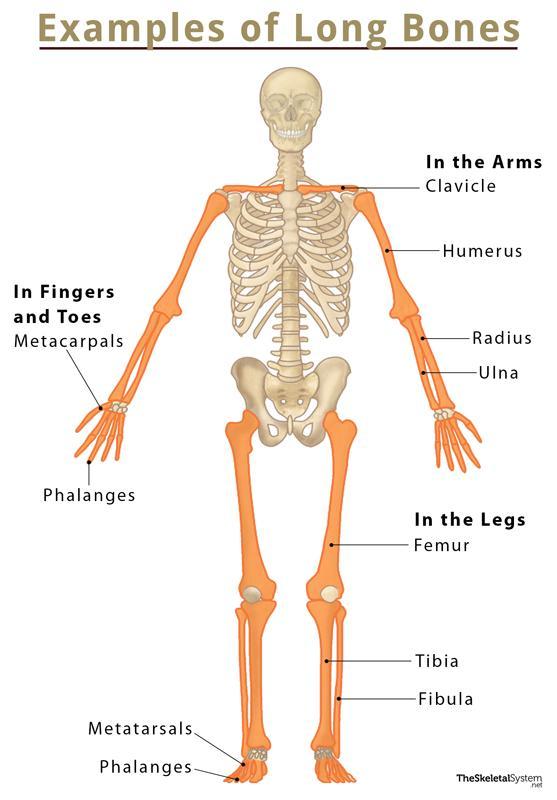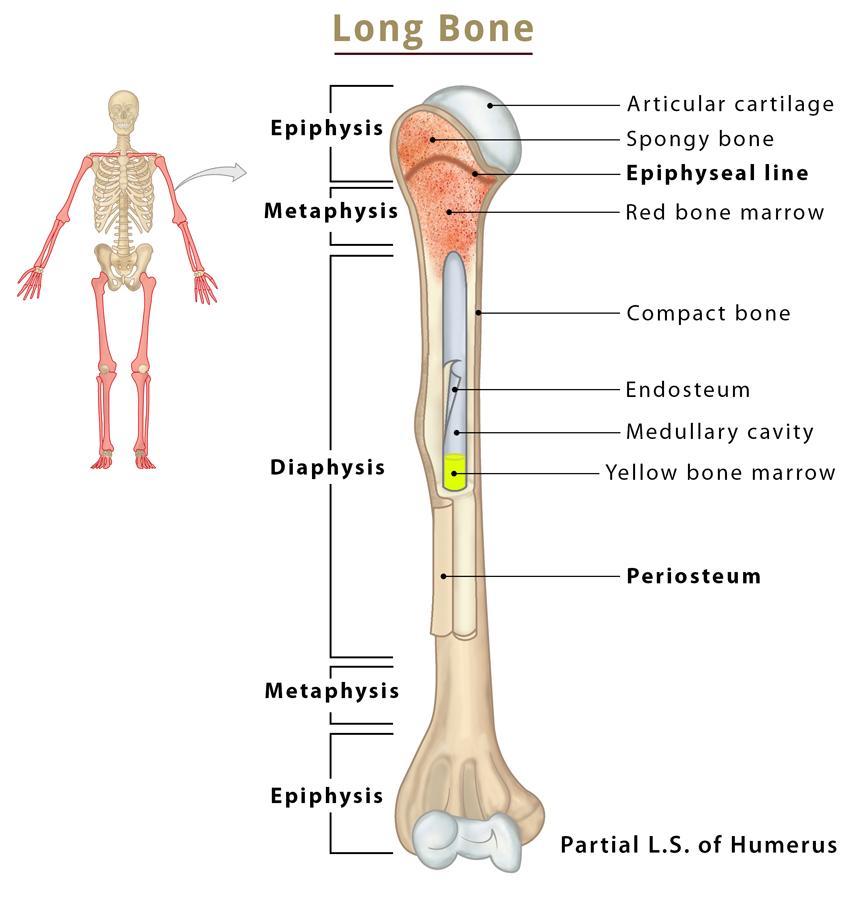Long Bones
As we know, 206 bones in total form the human skeletal framework. All these bones are classified into five types based on shape, and one of the primary types is the long bone.
What is a Long Bone
As the name says, a long bone is a tough, dense bone with an elongated shape. These bones are primarily present in the legs and arms. The bones of fingers and toes are also considered long bones. It is because this classification is based on the shape of a bone, not size.
Examples of Long Bones in the Body

Functions
- Supporting body weight
- Acting as a lever to facilitate movement
- Providing strength and structure to the upper and lower limbs
Anatomy of a Long Bone
A long bone can be divided into two parts – (1) the central shaft or diaphysis and (2) the epiphyses (singular: epiphysis), the bulky ends on both sides. There is a narrow section called (3) metaphysis between the diaphysis and epiphysis. Also, a membrane called (4) periosteum covers the bone.
1. Diaphysis
The central tubular shaft connects the two ends of the bone. Its walls are composed of dense and hard compact bone, forming an internal hollow region called the medullary cavity (as shown in the cross-section image above). This cavity contains yellow bone marrow, helps in fat storage, and is internally lined by a delicate membrane called endosteum (endo- inside; osteo- bone;). The endosteum helps the bone grow, remodel, and repair or heal from fractures.
2. The Epiphyses
As stated, these are the two extremities of the bone. The end which lies closest to the center of the body is termed proximal epiphysis or proximal end. In contrast, the one lying away from the center of the body is referred to as distal epiphysis or distal end.
The epiphyses are composed of spongy bone filled with red bone marrow. This marrow contains blood stem cells that produce red and white blood cells and platelets.
The extreme ends of the epiphyses, where they articulate with other bones, is covered with articular cartilage. This cartilage protects the surfaces from friction and absorbs mechanical shock at the joints.
3. Metaphysis
It is where the diaphysis and epiphysis connect. In a growing bone, this region contains a growth plate called the epiphyseal plate, composed of a layer of transparent hyaline cartilage. Around 18-21 years of age, the cartilage gets replaced by bony tissues, and the bone ceases to grow. This is when the ossification of the area is complete, and the epiphyseal plate is left as the epiphyseal line.
4. Periosteum
‘Peri’ means ‘around’ or ‘surrounding’, while ‘osteo-’ stands for ‘bone’. So it is clear from the name that the periosteum is a fibrous membrane that covers the outer surface of a long bone. The two ends covered in cartilage are the only part of the bone not covered by the periosteum.
The membrane has blood vessels, nerves, and lymphatic vessels that carry the required nutrients and respiratory gases to the compact bone. The ligaments and tendons attached to a long bone also anchor here.
FAQs
A: In a long bone, growth occurs at the epiphyseal plate. It causes the bone to grow lengthwise.
A: There are around 90 long bones in the human body.
References
- Long bones — Mountsinai.org
- Long bones — Medlineplus.gov
- Classification of Bones — Training.seer.cancer.gov
- Anatomy of a Long Bone — Bio.libretexts.org
- Bone Structure — Pressbooks-dev.oer.hawaii.edu


